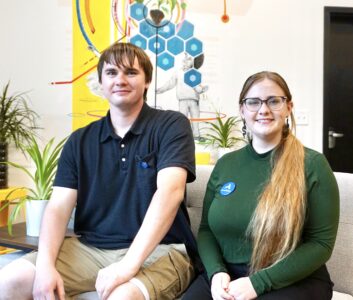ASTEP at Minot State prepares graduates for independence

Submitted Photo Family and friends look on during the graduation of five students in the ASTEP program at the North Dakota Center for Persons with Disabilities. Students were honored at their graduation ceremony on May 5 in Hartnett Hall at Minot State University.
Minot State University’s Class of 2025 will be recognized at the university’s commencement ceremony this morning, which will include five graduates of the Advancing Students Toward Education and Employment Program (ASTEP).
A part of the North Dakota Center for Persons with Disabilities (NDCPD), ASTEP was North Dakota’s first Inclusive Post-Secondary Education (IPSE) program, beginning in 2010 as a part of the ND Inclusive Model Pathways for College and Career Training Consortium (IMPCCT).
The consortium sought to develop IPSE programs with higher education institutions that would offer inclusive college classes and foster self-determination and campus inclusion for students with disabilities.
The five ASTEP graduates are Gavyn Herfendal, Jenna Holman, Mason Christianson, Nick Poolman and Paige Walth, who received their ASTEP College to Career certificates at a ceremony in Hartnett Hall on May 5. Holman also received a technical studies certification from Dakota College of Bottineau.
The graduates’ families shared testimonials at the ceremony, celebrating the students’ efforts as well as the program that set them on a course for independence and success in their future careers.
“If somebody is able to get a job that pays them a real wage, have their own apartment and contribute to their society, and they don’t need to live in a group home or some type of institutional type of a setting, it’s always better for the taxpayer,” Lori Garnes, NDCPD executive director, said. “Now after three years at Minot State, Paige Walth is going to move into her own apartment, and actually have more possibility than either of the other options could have possibly given her.”
Garnes found ASTEP’s real virtue has been providing its students a true college experience in an environment that exposed and included them. Garnes said Nick Poolman’s mother related that after three weeks at MSU her son was a different person.
“He was more confident, more outgoing, more secure and self assured. The program didn’t have a chance to teach him all that much yet, but it was being away from home, the dorms, on his own and making friends like everybody else,” Garnes said.
This immersion on campus and classroom is led by five ASTEP adviser staff, and 50-75 MSU students who serve as peer mentors. The peer mentors work with the students day to day by going to class and attending social activities.
“They really make a difference. One of the mothers said, ‘I think you’re part of the family now,'” Garnes said.
The ultimate goal of the initiative is to provide an opportunity for students to develop pre-employment skills for career development and enable them to live independently.
According to information from the IMPCCT, 89 students have enrolled in the last 15 years. The number of enrolled students has grown from four in 2011-2012 to 29 in the 2024-2025 academic year, as North Dakota State University and Valley City State University have created their own IPSE programs and others are exploring creating programs of their own.
“That would be awesome to have programs like this all throughout the state so people wouldn’t have to move so far away from home. Or all the reasons why you pick your school: it has the majors that you want, it has the location that you like, or it’s your parents’ alma mater and you like the sports team,” Garnes said.
IPSE programs in North Dakota have a 51% completion rate, compared to other two-year colleges which have a completion rate of 34%. Additionally, 96% of graduates of North Dakota’s college programs, and 60% of graduates with intellectual disabilities are living independently.


